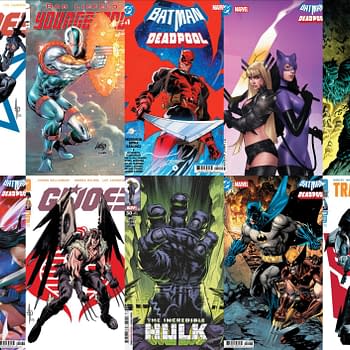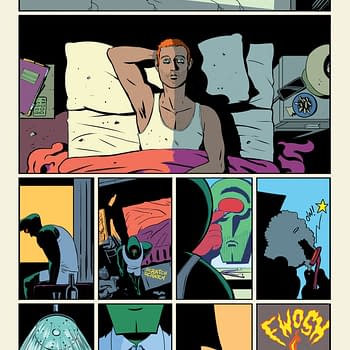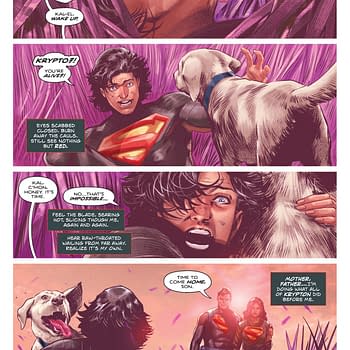Posted in: Comics | Tagged: 2016, comic, Comics, creators, dc, entertainment, female, gendercrunching, march, marvel
A New Marvel Record For Female Comic Creators – Gendercrunching March 2016
By Tim Hanley
DC's overall percentage of female creators ticked down slightly in March while Marvel's took a sizeable, record setting jump. We also take a look at another record setter, this year's Eisner nominations.
DC COMICS
After a higher start to the year, DC seems to be settling into the low teens, an area noticeably below their past bests. In March 2016, DC Comics put out 74 new comic books featuring 667 credited creators, 578 men and 89 women. Here are their charts:
DC's overall percentage of female creators fell 0.3%, a fairly inconsequential drop that nonetheless resulted in a relatively low total for the publisher. The numbers were up and down across the board, with small drops for cover artists, pencillers, inkers, and editors, and small gains for writers and letterers. The biggest swing was female colorists, who tumbled 7%, followed by female assistant editors, who rose nearly 4%. The changes all combined to a slight decline overall.
The Past Year at DC: March isn't looking much different from February, with both months among the lowest totals of the past 8 months:
The "Convergence" bumped April and May numbers aside, the second half of 2016 was much higher than usual for DC, and their current dip seems to be turning into a trend.
MARVEL COMICS
Meanwhile, Marvel's set a new company record for female creators. In March 2016, Marvel released 81 comics with 720 credited creators, 585 men and 135 women. Let's look at the numbers:
Marvel's 3.7% jump took them to 18.8% female creators overall, a new high for the publisher. As with every March at Marvel, their numbers were bolstered by variant covers celebrating female characters and creators; female cover artists jumped 6% from February. But female writers, pencillers, and inkers all saw small gains, along with an increase of nearly 7% for assistant editors. Colorists and editors dropped slightly, but the sizeable gains won the day.
The Past Year at Marvel: This chart shows the significance of Marvel's new high, relative to their past high but also the past six months:
Marvel's noticeably above their previous best of 17.2%, and well ahead of the initial months of their new, post-Secret Wars line up. The real question is whether they can keep it up; the chart also shows that past highs are no guarantee of high numbers the following month.
THE EISNER AWARD NOMINATIONS
The nominations for the 2016 Eisner Awards, the comic book industry's highest honours, were unveiled a couple of weeks back, and the announcement touted a "Record Number of Nominations for Women." The release went on to say, "The biggest news this year is that 49 women have received a record 61 nominations (compared to 44 last year) and are represented in 27 of the 30 categories. In fact, women make up the majority of nominees in seven categories." All of this is true, but raw numbers can be tricky. More female nominees are great, but if a higher number of men were nominated as well then the representation by percentage may not have changed very much.
But the percentages show that the Eisners have indeed set a record for female creators. The following graph charts the percentage of women nominated for Eisners for the past three years, and then back biannually from then all the way to 2004. The percentage is based on total nominations, so for example Colleen Coover got three separate nominations this year and gets credited for each of them in the tabulations. Here's a look at how this year stacks up:
So that's quite a jump. The overall total, 27.5%, is impressive in and of itself; women accounting for more than a quarter of the nominations is a massive change given that their percentage was in the single digits just a few years ago. Moreover, the change from last year to this year is sizeable. A jump of 8.5% is huge; there were several years where the Eisners didn't even have 8.5% female nominees overall! The past few years of nominations have highlighted a dramatic shift in the industry, none more so than this year.
By category, women were nominated in nearly 75% of the categories last year. This year, there are female nominees in 27 of the 30 categories, or 90%. That's quite a comprehensive field. Women are making comics at every level of production, in every genre and form, and are earning nominations accordingly.
For the past couple of years, we've compared the stats for the Eisner Awards to the Hugo Awards, the highest accolades for science fiction and fantasy which get announced around the same time. The comparison hasn't been particularly favourable. Last year, when a campaign by conservative writers hijacked the Hugo nominations to ensure that white, male voices would finally be recognized in science fiction and fantasy, the Hugos still had a higher percentage of women nominated than the Eisners did. That was a real buzzkill for what had been a record setting year for the Eisners.
But the tables have turned this year. Female representation at the Hugo Awards actually increased from last year, despite a similar conservative hijacking. The percentage of women nominated for Hugos rose from 22.7% in 2015 to 26.3%, but women taking 27.5% of the Eisner nominations puts the Eisners on top. While topping the hijacked Hugos isn't the most impressive of achievements, it nonetheless underscores how far the Eisners have come. Just two years ago, the percentage of women nominated for Hugos more than doubled those nominated for Eisners. The game has definitely changed in the wider world of comics, though growth in the superhero genre remains slow.
To learn more about this statistics project and its methodology click here, and to see the previous stats click here. You can visit Tim at Straitened Circumstances and follow him on Twitter @timhanley01. His first book Wonder Woman Unbound is available now, and his new book Investigating Lois Lane: The Turbulent History of the Daily Planet's Ace Reporter was released in March 2016.



















